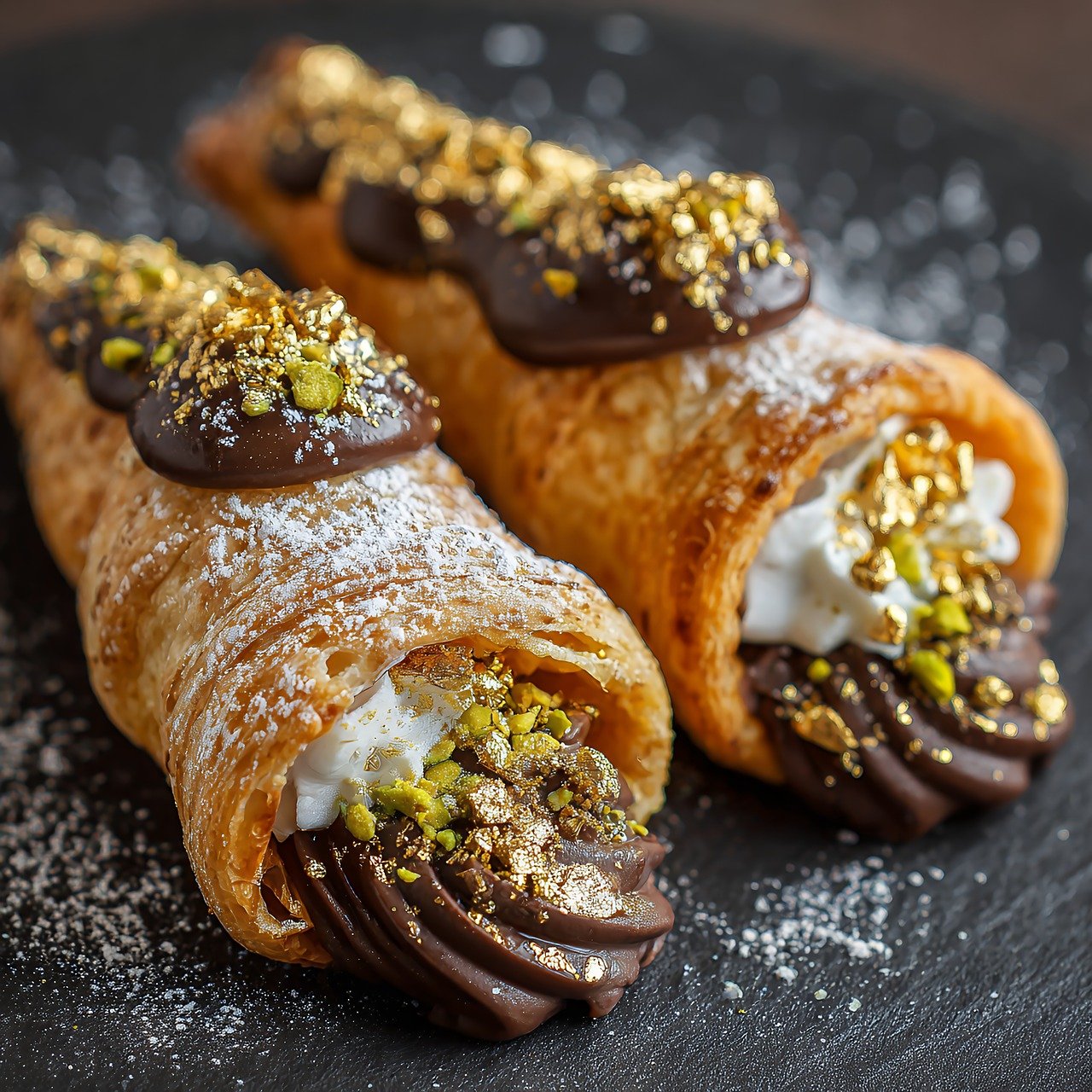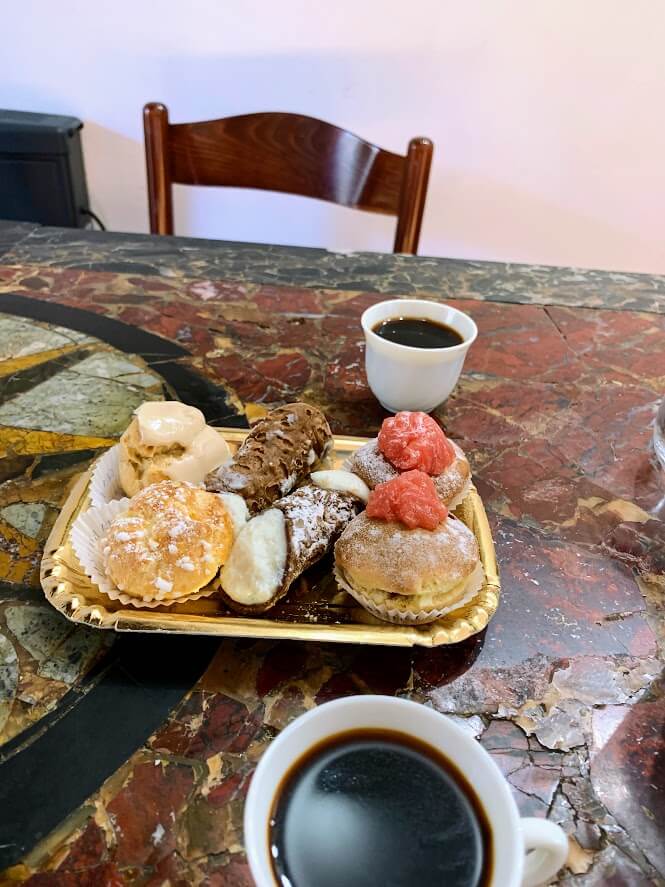- Home
- Sicilian Food
- Cannoli
The Art of Authentic Sicilian Style Cannoli: A Journey into Sicily's Most Beloved Dessert
When you bite into an authentic Sicilian style cannoli, the shell shatters with a satisfying crunch, giving way to a cloud of sweet ricotta that seems to melt on your tongue.
In that instant, you'll understand why over 2.5 billion cannoli are consumed annually in Italy alone—and why this humble Sicilian dessert has captured the hearts of people worldwide.
Real cannoli are a revelation—crispy, delicate shells filled to order with fresh sheep's milk ricotta, lightly sweetened and sometimes studded with chocolate chips or candied fruit.

The Sicilians don't just make cannoli—they honor centuries of culinary heritage with every crispy bite. They understand that shortcuts destroy the magic, and that patience and quality ingredients are non-negotiable.
These iconic pastries have become synonymous with Italian-American bakeries across the United States. Still, the authentic Sicilian version tells an entirely different story.
Understanding what makes Sicilian style cannoli unique requires us to travel back to their origins on the sun-drenched island of Sicily.
Ready to begin this delicious journey?
History of Sicilian Style Cannoli
Cannoli have a rich history dating back centuries. Its exact origin is still debated. The most common belief seems to be that they were created during the Arab rule of Sicily. In this case, the name "cannolo" would be derived from the Arabic word "qanawāt," meaning "pipes" or "tubes."
Whatever the truth is, this name at least perfectly describes the shape of this iconic pastry.
Cannoli's popularity rose in the 9th century, first among the Sicilian nobility. From there, it quickly spread throughout the island. Later, it became a standard treat at many festivals on the island, especially during carnival time.
The recipes for traditional cannoli have been passed down through generations, each family adding their unique twist. Today, cannoli are found in almost every pastry shop in Sicily and Italian communities worldwide.
 Basic cannolo with chocolate chips on its head. (Photo: Alison Fayre)
Basic cannolo with chocolate chips on its head. (Photo: Alison Fayre)The Anatomy of Sicilian Cannolo
The Shell
Traditional Sicilian style cannoli are typically smaller than what you'd find in New York or Boston bakeries. The shells measure about 4 to 5 inches in length and maintain a delicate balance between the shell and filling.
Sicilian cannoli shells are made with a dough that includes Marsala wine, a fortified wine produced in the western Sicily. This ingredient adds a subtle complexity and helps create that signature crispy texture that shatters perfectly with each bite.
The dough is also enriched with lard or butter, sugar, and sometimes a touch of cocoa powder or coffee.
American cannoli shells tend to be thicker and sometimes lack the delicate crispness of their Sicilian ancestors. They're often made without Marsala wine, substituting it with white wine or even vinegar.
While these adaptations work in their own right, they produce a different flavor profile that moves away from the authentic experience.
The Filling
The filling is where Sicilian cannoli truly shine and diverge most dramatically from other variations.
Traditional Sicilian cannoli use fresh sheep's milk ricotta, which has a distinct flavor and texture compared to the cow's milk ricotta commonly used in America. Sheep's milk ricotta is slightly grainier, less watery, and possesses a more complex, somewhat tangy flavor.
In Sicily, the ricotta filling is sweetened but not overly so. Sicilian pastry chefs understand that the filling should complement, not overwhelm, the shell.
They typically use fine sugar and sometimes add miniature chocolate chips, candied orange peel, or pistachios. The filling remains relatively simple, allowing the quality of the ricotta to take center stage.
American and other Italian regional versions often incorporate heavy cream, mascarpone, or even cream cheese into the filling. While this creates a smoother, creamier texture that many people enjoy, it strays from the authentic Sicilian approach.
The addition of these ingredients can make the filling richer and sweeter, which may appeal to some palates, but alters the dessert's fundamental character.
Texture matters enormously in a proper Sicilian cannoli. The filling should be thick enough to hold its shape but still have a slight graininess from the ricotta.
 Cannoli and other Sicilian sweets from a local bakery in Palermo.
Cannoli and other Sicilian sweets from a local bakery in Palermo.Toppings and Decorations
The garnishes and decorations also differ between Sicilian and American styles.
In Sicily, cannoli are typically finished—perhaps with a dusting of powdered sugar and a candied cherry or piece of candied orange peel at each end. Chopped pistachios from Bronte, a town on the slopes of Mount Etna, are also traditional. And delicious.
American cannoli often feature more elaborate decorations. You might find the ends dipped in chocolate chips, rainbow sprinkles, or crushed nuts covering a larger portion of the shell.
Timing
The cannoli should never be filled until the moment of purchase or serving. The shells are prepared in advance and stored in airtight containers; however, the filling is added only when an order is placed.
This practice ensures the shell remains perfectly crispy.
Many American bakeries pre-fill their cannoli for convenience, which inevitably leads to soggy shells. Once that ricotta touches the shell, moisture begins transferring, and the textural contrast that makes cannoli so appealing starts to disappear.
If you're making Sicilian cannoli at home, remember the golden rule: fill them just before serving.
Regional Differences
Regional variations exist even within the island of Sicily itself. Cannoli from Palermo might differ slightly from those in Catania or Messina. Some areas prefer a hint of cinnamon in the shell dough, while others keep it plain.
The size can vary slightly, and some bakers add a touch of vanilla or lemon zest to the filling.
Other regions of Italy have their own takes on cannoli. In Calabria, for instance, you might find cannoli with a slightly different shell recipe.
However, when people worldwide think of cannoli, they're almost always imagining the Sicilian style cannoli that has become the gold standard.
Making Sicilian Style Cannoli at Home
Making authentic Sicilian cannoli at home is entirely possible, though it requires some special equipment and ingredients. And skills, which might take some practice.
You'll need metal cannoli tubes to shape the shells during frying, and finding good-quality sheep's milk ricotta might require visiting a specialty Italian market or cheese shop.
A proper Sicilian style cannoli recipe begins with the shell dough. You'll combine flour, sugar, salt, and a small amount of cocoa powder or coffee.
Cut in cold lard or butter until the mixture resembles coarse crumbs. Then, add Marsala wine and, if necessary, an egg to bring the dough together.
The dough needs to rest for at least an hour before rolling.
Rolling the dough requires patience and a light touch. It should be pretty thin—about 1/8 inch or even thinner.
Cut circles using a round cutter, then wrap each circle around a metal cannoli tube, sealing the overlapping edge with a dab of beaten egg white. This seal must be secure, or the shell will unravel during frying.
Frying the shells is the most critical step. The oil temperature should be maintained at around 350-375°F. Too hot, and the shells will brown before cooking through; too cool, and they'll absorb excess oil and become greasy.
 (Photo: Garrett Ziegler)
(Photo: Garrett Ziegler)Fry only a few at a time, turning them to ensure even browning, which should take about 2-3 minutes per batch.
Once golden brown, carefully remove the shells and let them cool slightly before sliding them off the tubes.
Be gentle—they're fragile when hot.
Allow them to cool completely on a wire rack before storing in an airtight container. Properly stored shells can last several days, maintaining their crispness and freshness.
Preparing the filling requires quality ingredients above all else. If you can find sheep's milk ricotta, use it. If not, the best ricotta you can find will suffice. However, it's recommended to drain it in cheesecloth for several hours to remove excess moisture.
This step is non-negotiable for achieving the right consistency.
Mix the drained ricotta with powdered sugar, adjusting the sweetness to your preference. Traditional recipes use less sugar than you might expect—the filling should taste of ricotta first, sweetness second. Fold in mini chocolate chips or finely chopped dark chocolate if desired.
Some recipes call for a splash of vanilla or a hint of cinnamon, although purists often omit these additions.
When you're ready to serve, transfer the filling to a pastry bag fitted with a large plain tip. Pipe the filling into one end of the shell, then turn it around and fill from the other end, ensuring the cannolo is wholly filled with no air pockets.
This technique ensures every bite contains the perfect ratio of shell to filling.
Garnish, as they do in Sicily. Dip the filled ends in chopped pistachios or mini chocolate chips, add a small piece of candied fruit if desired, and dust the entire thing lightly with powdered sugar.
The restraint in decoration allows the fundamental elements to shine through.
The experience of eating a properly made Sicilian cannoli is genuinely something special. That first bite should deliver a satisfying crunch as your teeth break through the shell, followed immediately by the cool, slightly grainy, sweet ricotta filling.
The flavors should be balanced, with neither element overpowering the other.
Understanding these differences helps you appreciate why Sicilian cannoli have remained so beloved for centuries. They represent a perfect example of how simplicity, when executed with quality ingredients and proper technique, creates something far greater than the sum of its parts.
This philosophy runs through much of Sicilian cuisine.
If you're planning to make Sicilian cannoli at home, don't be discouraged if your first batch isn't perfect. Becoming a skilled cannolo maker takes practice.
The dough might be too thick, the filling too loose, or the shells might not achieve that perfect golden color. Each attempt teaches you something.
The beauty of following a traditional Sicilian cannoli recipe is that you're connecting with a culinary tradition that has survived and thrived for over a thousand years.
You're making the same dessert that Sicilian grandmothers have been preparing for generations, using techniques passed down through families and refined over centuries.
 "Come on nonna, time to get us some of those delicious cannoli!" (Drawing: Redmer Hoekstra)
"Come on nonna, time to get us some of those delicious cannoli!" (Drawing: Redmer Hoekstra)Conclusion
Whether you're enjoying Sicilian cannoli in a pasticceria in Palermo or making them in your own kitchen thousands of miles away, you're participating in a delicious piece of cultural heritage.
Also, after you grasp the basics, it's not a sacrilege to experiment with different variations. Many chefs around the world, including in Sicily, are experimenting with their own variations on cannoli.
Still, if you want to honor the tradition, there is no better way to do it than doing it the Sicilian way. And that's something worth preserving, one crispy, creamy, heavenly bite at a time.
(October 28, 2025)
Recent Articles
-
Best Time to Visit Sicily: Your Seasonal Guide
Dec 05, 25 04:23 AM
Find the best time to visit Sicily. Explore seasonal weather, crowds, prices, and highlights. -
Where to Stay in Sicily: Top Areas for Every Traveler
Nov 27, 25 08:14 AM
Where to stay in Sicily: A guide to the island’s best regions, helping you choose the perfect base for your trip. -
Cefalu Beaches: Where Sun, Sand, and Calm Await
Nov 26, 25 12:10 PM
Discover Cefalu beaches where warm sands, clear waters, and coastal charm come together.
Follow MANY FACES OF SICILY on Facebook, Instagram, Bluesky & Tumblr
Contact: vesa@manyfacesofsicily.com







